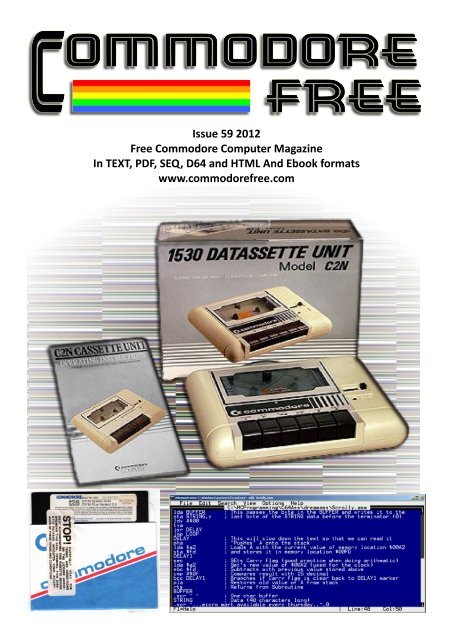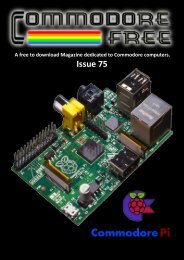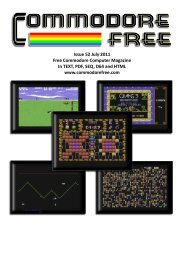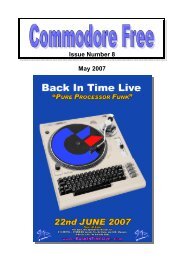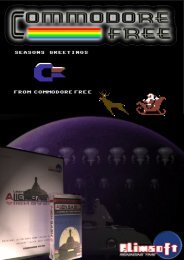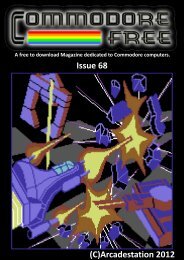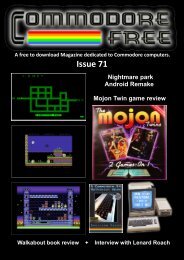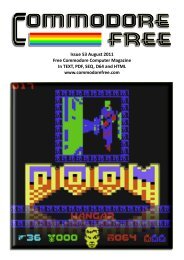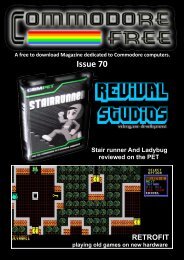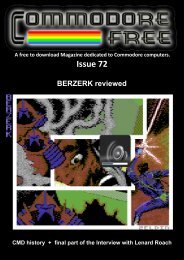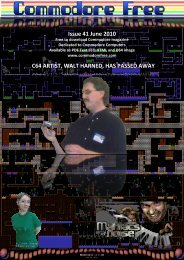Commodore Free Magazine Issue #59 (PDF)
Commodore Free Magazine Issue #59 (PDF)
Commodore Free Magazine Issue #59 (PDF)
- No tags were found...
You also want an ePaper? Increase the reach of your titles
YUMPU automatically turns print PDFs into web optimized ePapers that Google loves.
<strong>Issue</strong> 59 2012<strong>Free</strong> <strong>Commodore</strong> Computer <strong>Magazine</strong>In TEXT, <strong>PDF</strong>, SEQ, D64 and HTML And Ebook formatswww.commodorefree.com
www.commodorefree.comCONTENTSEDITORIAL PAGE 2READERS COMMENTS PAGE 5NEWS PAGE 5Digimaster 128 released!NEWS PAGE 7OpenCBM ArchiverDeeds of YoreResults of the Amiga Games Award 2011NEWS PAGE 8CBM-COMMAND UPDATEDPixelJam DemopartyNEWS PAGE 11MORE GAMES THAT WERNT FOUNDAngel of Hell IIPenPalzNEWS PAGE 12A-EON Updates "Boing Ball" re-visitedNews from A-EON TechnologySam440ep_setup 1.3 ReleasedNEWS PAGE 13PDXCUG.org Meeting ReminderC=FREE WELL I MISSED THE DEADLINE BUT.....iBatch V1.4: new Features/ ScreenshotsNEWS PAGE 1414AmiDARK Engine Rel0.5 is Now Available!NEWS PAGE 15iBatch V1.4: new Features/ ScreenshotsEF3 USB Utilities v1.2NEWS PAGE 16FREESCAPE GAME NEW ISHNEWS PAGE 17AmigaOS 4.1 Update 5 CD for the AmigaONE X1000"First Contact" system has gone GOLD!S U D O K U by John Borrowman PAGE 18ASSEMBLER TUTORIAL PART 2 PAGE 19FROM MICROMART BY SHAUN BEBBINGTONThe Datasette PAGE 25By Francisco Javier Gonzalez CañeteRediscovering <strong>Commodore</strong> CP/M PAGE 31by: <strong>Commodore</strong>man ©Page 2
EDITORIALwww.commodorefree.comThe Second issue of 2012and in this issue we have the continuation of the assemblertutorial for the <strong>Commodore</strong> 64 courtesy of Shaun Bebbingtonand Micro mart magazine, building on from what we learnt lastissue. More news as usually for the magazine, and although Isay it every time it still surprises me that for such a supposedlydead platform we have a large amount of news and projectsgoing on.Also we have a look at the datasette and how software wasloaded from tape or more correctly the TAP format, for anumber of years I only had a datasette to load games andprograms from, although it could be tediously slow, (Iremember some titles taking about 20 minutes to load if theydecided they wanted to ) and very unreliable the process couldbe, the one thing about tape was the suspense of the loadingespecially when turbo loaders came in, with music and loadingpictures. I know some of the disc games started using loadingpictures but it didn’t feel the same, and the horrendousknocking sound and watching my drive dance around trying toread the copy protection put me off discs. Some loadingsystems would even have a countdown timer until the gamestarted, while other had mini games to play until the maingame loaded. I still load from tape for this very reason, thewaiting time (now down to minutes) still adds to the gamesappeal, and when the picture does finally come up and thenthe music starts; your literally trembling with anticipation. Ofcourse should you only have a short time to look or play agame or use a utility then loading from some other system ismore preferable, especially now with new hardware able toload applications very quickly indeed.MISSINGWe have a reader’s comment plea to find a missing book forthe +4 computer about programming entitled “an introductionto basic part 2” of course if you can help please contact<strong>Commodore</strong> <strong>Free</strong> and I will pass on any information. I wouldlove to find this book or even notes about the book for thereader. Finding the author would of course be a major pluspoint.CP/MWe finish off this issue with a look into the world of CP/M and ausers initial looks at finding resources and questions about thesystem and its use in the <strong>Commodore</strong> 128, If you feel youcould expand this then let me know, I am sure many users arecurious about CP/MAgain I would like to sayI am planning a <strong>Commodore</strong> 264 edition; this will cover thecommodore 116 commodore 16 commodore plus4 etc, If youwould like to contribute to this issue, and so far I have only 2people willing to help. Please contact me. This is now yourchance to tell the world why this range of machines was sogood and why you still use the machine today. It could be amemory about the machine; article or a technical article. Doyou know why the range was started and why <strong>Commodore</strong>changed the design, creating the plus4 and c16 and do youknow what system they were competing against (feel free towrite to me at the usual address and let others know) Ofcourse I have a good idea why the system was created by<strong>Commodore</strong> and its major competitor, but I feel this would bebetter written by an actual 264 fan rather than myself.Although I am a fan of the range I am no expert on the system.Now is your chance to let the machines shine out and teachthe masses!RegardsNigel Parker (pretend editor)<strong>Commodore</strong> <strong>Free</strong>www.commodorefree.comPage 3
Has any-one ever seen,heard of or know the whereabouts of Prof. Andrew Colin?You will of course be aware he wrote all the “Introduction toBasic” books for <strong>Commodore</strong> range of machines -I think all upto the Amiga. But certainly he created the series for the VIC,C64, & C16/+4s.The thing is. Many of 'us' 16/+4 users are dying to know whateverhappened to part 2 of The Series of "An Introduction toBASIC..." for c16/+4, The burning question I keep asking is“Was part 2 ever made”, does it exist, can we get a copy?I have both the c64 books, haven't had chance to read themthrough yet though. I Never bothered with the VIC -bless it,perhaps I will someday in the none too distant future.I think you're the last hope (<strong>Commodore</strong> <strong>Free</strong>) with above plea,Please can you ask the readers for help if you can.I would love to read that book, and know how my main compprog. teacher by books is?Best Wishes Jn.Readers CommentsNEWSwww.commodorefree.comCOMMODORE FREESo you have it has anyone ever seen Part 2 of the book series“an introduction to Basic for the +4” does it exist in any formatand is Prof. Andrew Colin still alive and well to ask?Digimaster 128 released!-----Original Message-----From: Robert BernardoTo: commodorefree@commodoefree.comSubject: Digimaster 128 released!Based on Autumn Technologies' Digimaster for the C64,Hydrophilic has released Digimaster 128 for the C128 in 40-column mode. Digimaster is the digital audio sampling andediting software for the C64 and now for the C128. Withsampling rates up to 12,439 cycles, Digimaster has a graphicalinterface which makes cutting and pasting samples easy.Digimaster is meant to work with audio samplers, such as theSound Ultimate Xpander 6400.If you are registered at www.commodore128.org, you can seea screenshot .gif of Digimaster 128 and download a zip of theprogram and its development notes. Digimaster 128 isshareware; keep reading the above thread in order to find outhow to PayPal money to Hydrophilic.If you are not registered at www.commodore128.org, go tohttp://retro-link.blogspot.com/2012/02/digimaster-128-released.htmlin order to see a screenshot of the program. (<strong>Commodore</strong><strong>Free</strong> see attached photo)Digimaster 128 boasts improvements over its older C64cousin. With the C128's greater memory, the program cannow capture sound samples approximately twice as long asthe C64 version. Now when the screen is blanked duringhighest-quality sound sampling, the program switches into theC128's 2 MHz. mode. Also when run, DM 128 auto-detectswhether the <strong>Commodore</strong> is NTSC or PAL and then runs theprogram appropriately. DM 128 takes advantage of the C128'sfaster serial loading when loading samples.To read more about Digimaster 128, go tohttp://www.commodore128.org/index.php?topic=4162.msg20510;topicseen#msg20510Truly,Robert BernardoFresno <strong>Commodore</strong> User Grouphttp://videocam.net.au/fcugPage 5
www.commodorefree.comPage 6
OpenCBM ArchiverNEWSwww.commodorefree.comOpenCBM Archiver is a small program to help automate thecreation of disk images using OpenCBM. With OpenCBMArchiver, you only need to press a key between disks and anew image will be created using the next number in asequence.You can download OpenCBM Archiver at:http://opencbmarchiver.codeplex.comDeeds of YoreOstrog Productions Presents...The story of David Grigsby, a young man in 1987 who lovesvideo games. One night, after losing his car, his job and hisgirlfriend, David gets sucked into a video game called... DEEDSOF YORE!The first 2 episodes are live action featuring the C64, the restseems to be <strong>Commodore</strong> style animationshttp://www.youtube.com/user/ostrogproductionsResults of the Amiga Games Award 2011On February 4th 2011, the magazine Obligement haveannounced the results of the Amiga Games Award 2011. Thisrepresents the best Amiga games voted by amigans on allAmiga platforms.For AmigaOS 68k :1. Mr Beanbag (Jigsaw Lounge)2. Bermuda Syndrome (Century Interactive)3. Barrage (Michael Speck)For AmigaOS 4.x1. 1941 Extreme Deluxe Dual Players 2.0 (Badblocks, HuguesNouvel)2. Swamp Defense (EntwicklerX).3. River Pirate (EntwicklerX).For MorphOS1. Return To Castle Wolfenstein (ID Software, Gray MatterInteractive)2. 1941 Extreme Deluxe Dual Players 2.0 (Badblocks, HuguesNouvel)3. Simutrans (Hansjoerg Malthaner, Simutrans Team)For AROS1. UFO: Alien Invasion (UFO: Alien Invasion Team)2. Assault Cube (Rabid Viper Productions)3. Cube 2: Sauerbraten (Wouter Van Oortmerssen)More information on :http://obligement.free.fr/hitparade/award2011.phpPage 7
CBM-COMMAND UPDATEDWhat is it?CBM-Command is a disk manager for the <strong>Commodore</strong> 64,<strong>Commodore</strong> 128, <strong>Commodore</strong> VIC-20, <strong>Commodore</strong> Plus/4,and <strong>Commodore</strong> Pet/CBM computers. It is written in the veinof Norton Commander or Midnight Commander; but, it ismuch simpler due to the target platforms. Each <strong>Commodore</strong>model has its own native version of the application.New Features:- It can detect the formats of Creative Micro Design's partitionsand sd2iec's disk images.- It knows automatically when to create either single-sided(D64) or double-sided (D71) images.- CBM 8050 and CBM 8250 (SFD-1001) disk copier.Changes from 2.1rc2:- After showing a message, the status line always will let youknow when you have tapped the RETURN-key.http://cbmcommand.codeplex.com/NEWSwww.commodorefree.comPixelJam Demopartyafter the 10th the registration fees go up.From: Robert BernardoSent: FebruaryTo: <strong>Commodore</strong>free@commodorefree.comSubject: PixelJam Demoparty at Notacon 9, April 12-15Demoparty time! The PixelJam Demoparty crashes throughagain during Notacon 9 in Cleveland, Ohio, U.S.A, April 12-15.Join the 300-400+ attendees who will be descending upon theHilton Garden Inn Hotel there.Get those demo entries in! PixelJam is looking for demosranging from the most modern to old-school. For the<strong>Commodore</strong> and Amiga enthusiasts, your entries can be in theold-school, wildcard, or music compos. Here is some more info,straight from the Notacon blog, "PixelJam will feature a totalof 9 compos ranging from music to animation to traditionaldemos. Notacon itself has pledged over $1,500 in total prizemoney, with more prizes to be announced as we securesponsorship deals. We are also dedicating 2,500 square feet ofconference space to a coding lounge and projection space.This space will be expanded by an additional 3,000 square feetfor demo screenings on Saturday night the 14th."Play with the other happy enthusiasts in the Video and BoardGame room. Open 24 hours a day, the game room will haveeverything from the most modern consoles to <strong>Commodore</strong>and/or Amiga computers to board games. (The Fresno<strong>Commodore</strong> User Group will not be able to attend this time,but Keith M. and others will fill in.) Listen to the variouspresentations from those at Notacon 9. Speak out at thebroadcast at Notacon Radio. Check out the Notacon hackingroom. Or hang out in the Notacon Ham Radio room or in thecoding lounge.Early registration closes on Feb. 10. Register now, becauseFor more information, go to the Notacon website athttp://www.notacon.orgFor more demoparty info (though not yet updated with thisyear's bits), go tohttp://www.pixelj.amTruly,Robert BernardoFresno <strong>Commodore</strong> User Grouphttp://videocam.net.au/fcugPage 8
MORE GAMES THAT WERNT FOUND'ANGEL OF HELL II'Angel of Hell II is a preview of a game by 576 KByte which wasproduced back in 1996. Sadly it never got completed. It wasthe sequel to this game.The preview spans a very impressive 3 disk sides, and comeswith a superb introduction sequence which then brings youonto the main game itself.The game needs an English translation, so I cannot describemuch about the game's story at present - but the game is animpressive looking icon driven graphic adventure game -which looks very promising indeed.Development of the game overall got quite far, but it seemsthat it was quite late into the C64's life, and possibly due topoor sales of previous titles - the game was abandoned as aresult. Recently Jazzcat managed to get hold of the remains onthe game which we can now present to you to check out foryourselves.It seems a shame that this one never quite got finished, as itlooked very promising and might not have been that far awayfrom completion. Still, at least it is now preserved and peoplecan get an idea of what might have been. Please refer to thetext file for instructions on how to get some of the separateparts working.We hope to hear from the developers themselves about thegame and the intentions very soon!NEWSwww.commodorefree.com'PEN PALZ'1997 John Pericos and Nathan PerryPenPalz was a neat little game that was being developed backin Jan 1997 by John Pericos and Nathan Perry - intended forGO64.The idea is simple - draw on the screen as much as you can andtry to fill in a certain percentage of the screen before timeruns out. Sort of like Qix in many ways - and with the sameproblem of having creatures on the screen which are trying tostop you. Collecting the bonus colour blocks on the screen arethere to make your life far easier. Although the game got to apromising early stage (with titles, music and at least a level) -unfortunately the game was never finished due to bothdevelopers getting tied up and busy at University. After that,the game was shelved and forgotten about, and John wentonto developing for the GameBoy.In early 2012, John got in touch with GTW64 and offered thegame to us. He had been cleaning up stuff in his old room at hisparent's house and found a bunch of disks - one of which hadthe last version of PenPalz. To ensure it got preserved andshare it with others, John kindly passed on a copy of the gameto put on the website. And here it is! The game is fully playable,and contains one level for you to try. This is as far as the gamegot before it was shelved. The download also includes a textfile which explains more about how to play the game.John offers hope that maybe one day he may even completethe game - however, John lost contact with Nathan Perry andhopes that maybe this entry will get Nathan in touch again tomaybe get this project moving again. If you're out thereNathan, then please get in touch! For now, check out thissuperb preview of a very promising game!Frank (Additional source credits - John PericosFrank and Jazzcat.CreditsCode - Robért OlessákMusic - Olivér GáspárGraphics - Unknownhttp://www.gtw64.co.uk/Pages/a/Review_Angelofhellii.phpCreditsCode - John PericosMusic - Sidchip ScratchersGraphics - Nathan Perryhttp://www.gtw64.co.uk/Pages/p/Shots_Penpalz.phpPage 11
A-EON Updates "Boing Ball" re-visitedNews from A-EON TechnologyHardware Accelerated 3D using 2D CompositingAmigaOS graphics guru, Hans de Ruiter, has issued anotherupdate to his RadeonHD graphics driver for the AmigaOS.Version 0.32, which makes its official debut on the AmigaOS4.1 Update 5 CD especially created for AmigaONE X1000 "FirstContact" system, delivers full 2D support for all Radeongraphics cards from the Radeon X1300 through to theRadeonHD 4890. When asked about the improvements in hisnew driver De Ruiter said, "I'm quite pleased with the updateddriver. Apart from fixing a few bugs, the biggest change is theaddition of homogeneous texture coordinate support to thecompositing function. This allows 2D warping and evenperspective-correct texturing". In reply, A-EON Technology'sTrevor Dickinson commented, "I am pleased to help supportHans' graphics driver work and look forward to the futurerelease of hardware accelerated 3D graphics drivers whichshould benefit the AmigaONE X1000 all other AmigaOS 4users".To illustrate the improvements in his new driver De Ruitercreated "Composite3DDemo", an interactive 3D "Boing Ball"demo remake that renders everything using hardwareaccelerated 2D graphics without the use of 3D drivers.Originally developed as a test application for the RadeonHDdriver running on the AmigaONEX1000, it demonstrates what canbe done with AmigaOS 4.1'spowerful compositing feature anda little creative thinking. In othergood news De Ruiter revealed thathe is releasing the source-codewhich he hope will help others touse these features, and encouragethem to see what they can do. The"Composite3DDemo" is included onthe AmigaOS 4.1 Update 5 CD andcan be downloaded from the weblink shown below. Please alsocheck the link to the "YouTube"video.NEWSwww.commodorefree.comAbout Hans de Ruiter & HDRLab: Hans de Ruiter is an electrical& electronics engineer and leading AmigaOS developer andAmiga enthusiast. His website - HDRLab - details variousprojects, many of which are AmigaOS related. The biggest ofthese is the RadeonHD driver for AmigaOS, an ambitiousproject that aims to deliver modern graphics capabilities forthe AmigaOS platform.Links:Composite 3D Demo downloadhttp://hdrlab.org.nz/projects/amiga-os-4-projects/c3d/RadeonHD development loghttp://hdrlab.org.nz/projects/amiga-os-4-projects/radeonhddriver/radeonhd-development-log/radeonhd-chip-0-32-bugfixes-and-fully-working-2d/Composite 3D Demo videohttp://www.youtube.com/watch?v=pDDBhGLTPPIA-EON Technologyhttp://a-eon.com/YouTube Linkhttps://www.youtube.com/watch?v=pDDBhGLTPPI&feature=player_embedded#Sam440ep_setup 1.3 Releasedfrom m3x viaSam440ep_setup is a little utility to optimize performance onyour Sam440ep board (mini-itx and flex versions)What's new:use a more aggressive instruction cache speculativeprefetching setting. This allows a faster execution for somesoftware, for example the following Blender speed testincreased performance by 10%-20%:bldyn -b projects/bricks_and_water_plugin.blend -o ram:pool-F JPEG -f 0As a side note some values returned by Ragemem areincorrect (MIPS) or lower (L2 cache read64/write64) when thissetting is enabled. To disable this setting, add NOCCRargument to the command line.Currently on OS4Depot upload queue. http://os4depot.net/Page 12
PDXCUG.org Meeting ReminderC=FREE WELL I MISSED THE DEADLINE BUT.....------------- Original Message ---------------Subject: PDXCUG.org Meeting ReminderFrom: "PDXCUG Admin"Hello, PDXCUG.org Fans!Missed last month? See the meeting highlights:http://pdxcug.org/meetings.aspUnable to attend the meeting in person? No worries.Come chat with us using your RR-NET or Comet64 (or useeither in VICE).- We'll be chatting with you live from the meeting.- Interact with others <strong>Commodore</strong> enthusiasts around theworld.- Play online games with othershttp://pdxcug.org/Portland-<strong>Commodore</strong>-Users-Group-Meetings-Live-Online.aspFind us in the c64 chat roomPDXCUG.org Meeting:Thursday, February 9, 2012 @6:00 pm - come as early as 5:00pm More info & location: http://pdxcug.org/meetings.aspThis Month's Meeting Agenda:Feature: <strong>Commodore</strong> 16Demo: C64List 3.0Demo: TBATinker Time: Time for YOUR projectsMusic Time: We'll have some software to make and play coolmusic Gaming Time - Countdown to Shutdown: Preventmeltdown at the nuclear facility Show & Tell - Bring your cool<strong>Commodore</strong> itemsNEWSwww.commodorefree.comAs usual, we'll have plenty of time for these other activities:- Gaming Time- Show & Tell: Bring anything you'd like to show off- Tinker Time:--Soldering-- Hacking-- Coding-- Repair-- Cleaning of equipmentWhat you can bring:- Show & Tell item - have something neat to show everyone?- Equipment that you want diagnose, fix, or just show off- Cool <strong>Commodore</strong> gear or software to share- Your significant other - plenty for all to do and enjoySee you there,- GoogPDXCUG.org is Portland's Official <strong>Commodore</strong> Users GroupServing the greater metropolitan area - Portland, OR USAMeetings every 2nd Thursday of the monthTwitter: @pdxcughttp://pdxcug.orgiBatch V1.4: new Features/ ScreenshotsNews from gerographHello,...As promised, find feature list of upcoming iBatch V 1.4 below.Detailed infos, pdf Documentation and screenshots can beviewed on iBatch Website. However, iBatch V1.4 will not beavailable on that website for download, so checkwww.boingsworld.de website for updates. If you are intoGerman language make sure to listen to boingsworld.dePodcast/Episode 24. All the news will be in there, including aninterview with the iBatch author.New Features...- ignore aspect ratio when resizing- use wildcards when renaming- automatic selection of suitable scaling method (in "QualityMode")- bicubic- linear- window- with or without lowpassfilter- sharpen and soften your images- FXPlugins- Gamma correction for all images in batchlist- image too grayscale for all images in batchlist- add watermarkAll this resulted in a complete rewrite of the so called"conversion profile editor". A complete new GUI (seeScreenshot) will allow you to define different conversionprofiles even easier than before.Main Features since release...- batch converting, renaming, resizing, turning- jpg, png, bmp, iff-ilbm in/output- autonumbering when renaming- add capture date when renaming- all bundled in predefinable conversion profiles- built-in thumbnail viewer/batchlist creator- built-in batchlist browser- exif and embedded thumbnail support- plugin capability- html album plugin- image subtitle plugin (e.g. for html album)- workflow manager plugin- slideshow plugin (Win/AROS/Mac/Amiga)- transfer EXIF Header pluginPage 13
AmiDARK Engine Rel0.5 is Now Available!News from AmiDARKHi All,The new alpha build of the AmiDARK Engine is now availablefor both AmigaOS4.1 and MorphOS 2.7.Here are all the major changes between this build and theprevious one (that was only for AmigaOS4.1)I have Restructured entirely the archive content with more"specific" folders.NEWSwww.commodorefree.comUnder AmigaOS 4.1, the "Quit Application" key is always"Escape Key" as it work correctly.Here are the details of these 2 archives.What is important to know before downloading the AmiDARKEngine :The engine is under development, "Work in Progress". theauthor/developer may not be responsible for any problemthat can happen/occur when you Download/uncompress/usethe AmiDARK Engine alpha version. You use it entirely at yourown risk.1.Folder SDK that contain the .a library needed, it's the gameengine. Also contain the .h definition files needed to knowwhich functions are available.2.Folder HELP that'll contain all help in HTML file format.3.Folder RELEASE contain files like default app icon and an"AmiDARK Engine" logo you can put if you want in yourapplication.4.Folder "Source Code & Binaries" that contain all actualsource code and binaries :4.a : "Commands sets" will contain "function use"samples4.b : "DarkBASIC Professional" contain demonstrationported from DarkBASIC Professional to the AmiDARKEngine.4.c : Technical Demo" will contain special technologydemonstration.4.d : Will contain "default" project "skeleton"definition for varioustool (like AmiDevCPP,CodeBench, etc ... )that can be used tocreate new projectsIf you want to know all changes made from the previousAmiDARK Engine release 0.4c,Simply jump here : http://www.amidarkengine.com/spip.php?article28If you want to support the project, simply jump here :http://www.amidark-engine.com/spip.php?article6Here are the direct links to download these 2 builds :MorphOS 2.7+ build :http://files.amidarkengine.com/AmiD...ne_Release0.5c[MorphOS2.7].lzhAmigaOS4.1u4+ build :http://files.amidarkengine.com/AmiD...ne_Release0.5c[AmigaOS4.1u4].lzhI hope you'll enjoy test/development under the AmiDARKEngine.Kindest Regards,Frédéric "AmiDARK" CordierMany news sample, sourcecode, technical demonstrationand DarkBASIC Professionalportage will appear with thenext release of the GameEngine.I have also made manychanges/improvements in thegame engine.Don't forget that underMorphOS, the Escape Key don'twork under GLUT so, until thisbug is fixed, I've put the "QuitApplication" key to the FunctionKey F12.Page 14
iBatch V1.4: new Features/ ScreenshotsNews from gerographHello,...As promised, find feature list of upcoming iBatch V 1.4 below.Detailed infos, pdf Documentation and screenshots can beviewed on iBatch Website. However, iBatch V1.4 will not beavailable on that website for download, so checkwww.boingsworld.de website for updates. If you are intoGerman language make sure to listen to boingsworld.dePodcast/Episode 24. All the news will be in there, including aninterview with the iBatch author.New Features...- ignore aspect ratio when resizing- use wildcards when renaming- automatic selection of suitable scaling method (in "QualityMode")- bicubic- linear- window- with or without lowpassfilter- sharpen and soften your imagesNEWSwww.commodorefree.com- FXPlugins- Gamma correction for all images in batchlist- image too grayscale for all images in batchlist- add watermarkAll this resulted in a complete rewrite of the so called"conversion profile editor". A complete new GUI (seeScreenshot) will allow you to define different conversionprofiles even easier than before.Main Features since release...- batch converting, renaming, resizing, turning- jpg, png, bmp, iff-ilbm in/output- autonumbering when renaming- add capture date when renaming- all bundled in predefinable conversion profiles- built-in thumbnail viewer/batchlist creator- built-in batchlist browser- exif and embedded thumbnail support- plugin capability- html album plugin- image subtitle plugin (e.g. for html album)- workflow manager plugin- slideshow plugin (Win/AROS/Mac/Amiga)- transfer EXIF Header pluginEF3 USB Utilities v1.2SEQ file types are supported. Also single .PRG or .P00 files cannow be transferred over.EF3 Image Writer- This will write any .D64 or .D81 image on your PC over theUSB cable to the 1541/1581 drive on your c64. You can turnon VERIFY option which will verify each sector after the write.Upton 3 retries will be done.EF3 Image Reader- This will read a floppy disk in your 1541 or 1581 floppy driveon your c64 into a .D64 or .D81 image on your PC.This is the v1.2 release of the EF3 USB Transfer Utilities. Thistime with only bug fixes and a few additional features. Thefollowing utilities are present:Only 35 tracks .D64 images are supported. Also note that theTransfer (especially of the images) might be slow since Kernalroutines are used for maximum compatibility (and because ofmy lack of 1541 knowledge). So use Jiffy DOS or similar in yourC64 *and* your drive to make the transfer faster.USB Test- This utility will test your USB connection between PC and theEF3/C64EF3 Send- This will send a .PRG file over to the C64 and start it. This isvery fast: less than 3 seconds for 200 blocks. Files with sizes upto 250 blocks are supported. If the file does not load to $0801(basic start) then it will be started from its loading address(replacement for CodeNet).EF3 Copy- This will copy FILES that are inside of the .D64, .D81 or .D71images over to any drive connected to the C64. Only PRG andThere is a readme file present in the archive where you canfind more information.Link: http://pc.sux.org/tomcat/ef3utils12.zipNote: I cannot take responsibility for any damage to the dataor hardware these utilities might cause. Just to be on the safesideNew in 1.2: removed 40 track .D64 support since it was notworking. Added VERIFY option for EF3 Image Writer. Added.PRG and .P00 support to EF3 Copy utility.Best regards, TomazPage 15
FREESCAPE GAME NEW ISHFrom the website:<strong>Free</strong>scape GamesThis page is dedicated to the one of the best 3D Engine tocome out for the <strong>Commodore</strong> computer (Well, the best I'veseen so far). Here are a collection of games that uses<strong>Free</strong>scape engine.http://www.commodorecheetah.co.uk/<strong>Free</strong>scapeGames/<strong>Free</strong>scape.htmA Chance In Hell2011, Steven Flanagan.A Chance In Hell, Released 2011, Written by Steven FlanaganThis is a <strong>Free</strong>scape game created using the 3D Construction Kit.The game is public domain. You are free to copy it, host it, etc.Two versions exist:AChanceInHell.d64 - Standard C64 version - can be run on anyC64 or emulator.AChanceInHellEXtreme.d64 - EXtreme version for SuperCPU orfast emulation (Eg 25x)Essential Game Controls:You will need these controls to play and complete the game:O – forward (or joystick)K – back (or joystick)Q – left (or joystick)W - (or joystick)B – shoot/get/use/push/open (or joystick)P – look upL – look downI - Face forwardAdditional controls are as follows:Z - sidestep leftX - sidestep rightR = Move Up (Rise/Stand)F = Move Down (Fall/Crouch)U = U-TurnCTRL+key = When used in conjunction with movement keyswill accelerate the movement.ESC/RUN-STOP = Restart environment.CTRL+key = When used in conjunction with movement keyswill accelerate the movement.Control only required for the standard version:SPACE = Toggle Sights Mode/Movement Mode (not needed inthe EXtreme version)Controls that exist but you don't need:M = Tilt RightN = Tilt LeftA = Activate Object (not needed in this game)NEWSwww.commodorefree.comGame Story:The Devil has invaded your coastal village, and has kidnappedthe village population. As the village priest, you alone mustdefeat the devil and rescue your flock. A main road goesthrough the village, but don't expect anyone to stop for you asthey have heard the news.This is a short game that can be complete in one sitting. Thepuzzles are straightforward - there are no 'obscure' puzzles.The game is always completeable - there is no situation wherethe player cannot complete the game.Hints:* Walk into doorways to get through them.* If anything looks suspicious/useful, then try shooting it.* Make use of the look down and look up to see where you aregoing.* Remember this is a coastal village, with a cliff edgesomewhere!* There has been a twister recently so light objects may havebeen blown to high places.The EXtreme version of A Chance In Hell is revamped to runwith the SuperCPU or with a C64 emulator running atmaximum speed. A speed of 2500% (25x) is ideal. Any speedabove 10x is recommended. VICE and Frodo tend to be thebest emulators at reaching these speeds. Tip: Increasing 'skipframes' to 4 or 6 can help the emulator achieve these speeds ifyou have an older PC. At a speed of 25x, you will be rewardedwith a very smooth <strong>Free</strong>scape experience.Emulator speed guide for the EXtreme version:1x to 5x - too slow5x to 10x - ok10x to 15x - good15x to 20x - great20x to 25x - bestPage 16
AmigaOS 4.1 Update 5 CD for the AmigaONE X1000"First Contact" system has gone GOLD!News from A-EON Technology Newshttp://www.a-eon.com/AmigaOS 4.1 Update 5 CD for the AmigaONE X1000 "FirstContact" system has gone GOLD!A-EON Technology and Hyperion Entertainment are pleased toannounce that the AmigaOS 4.1 Update 5 CD, exclusivelycreated for the AmigaONE X1000 "First Contact" system hasgone gold. The professionally re-mastered CD will be suppliedin a printed boxed set along with copies of the AmigaONEX1000 and AmigaOS 4.1 "Quick Start" guides. Steven Solie,Hyperion Entertainment's AmigaOS Development Team Leadsaid, "The team worked hard to reach this importantmilestone in the development of the Amiga Operating System.With AmigaOS 4.1 Update 5 completed for the AmigaONEX1000 we can concentrate on versions for all the othersupported hardware platforms as we continue to pushtowards the future release of AmigaOS 4.2." Trevor Dickinsonadded, "I would like to thank the AmigaOS developers and thewhole AmigaONE X1000 beta test team who have worked sotirelessly behinds the scenes to make this a reality. I wouldalso like to give special thanks to a few key members of theteam who went above and beyond the "call of duty" to ensurethe success of this project. You know who you are." TheAmigaOS 4.1 Update 5 boxed set will be supplied to allAmigaONE X1000 "First Contact" customers who will alsoreceive a free update to AmigaOS 4.2 when it is commerciallyreleased by Hyperion Entertainment.AmigaONE X1000 "First Contact" systems now shippingA-EON Technology and AmigaKit are pleased to announcedthat the deliveries of AmigaONE X1000 "First Contact" systemshave commenced. Matthew Leaman, Managing Director ofAmigaKit commented, "we are pleased to finally supply thiseagerly awaited AmigaONE computer system to ourcustomers". Trevor Dickinson added, "I have just received myown AmigaONE X1000 system and I hope "First Contact"owners will have as much fun as I'm having with my new"Amiga". All that remains to be said is let's "keep this partgoing!"A-EON TechnologyAbout AmigaKit: AmigaKit is a trading division of LeamanComputing Ltd based in Cardiff, UK. It acquired the stock ofEyetech Group Ltd in 2006 and quickly established itself as aworld-wide market leader in the retail and distribution ofAmiga hardware and software. A-EON Technology appointedAmigaKit as its primary distributor for all its AmigaONEproducts.About A-EON Technology and the AmigaONE X1000: A-EONTechnology is the developer of the AmigaONE X1000 computersystem designed by Varisys Ltd for running the AmigaOS. TheAmigaONE X1000 is not like other computers. It is aculmination of efforts by real Amiga enthusiasts andNEWSwww.commodorefree.comdevelopers to create powerful, modern desktop hardware forthe Amiga Operating System. It is the natural evolution of theAmiga's PowerPC lineage and is based on the PA-Semi DualcorePA6T-1682M CPU and includes Xena, a "Software DefinedSilicon" co-processor. Above all it runs the latest version of theAmigaOS.About Hyperion Entertainment: Hyperion Entertainment is thedeveloper of the AmigaOS.AmigaKit website: http://www.amigakit.com/Page 17
The original version of this program was published onLOADSTAR #60 as 'digithunt' by Dave Johannsen. He was nodoubt ahead of the times because a few years later, puzzleslike this became the latest craze. These puzzles have appearedin almost all daily newspapers for the last decade.I modified the program to use a custom font with a large 2x2character set of numbers in a proportionally larger grid. I alsoused brighter colours and included ML routines from several ofthe Loadstar toolboxes. I did some 'tweaking' here and there,but the main algorithms remain (nearly) unchanged.Sudoku puzzles consist of a 9x9 grid, broken down into nine3x3 boxes. To solve a Sudoku, the numbers 1 thru 9 must filleach row, column, and box. Each number can appear only oncein each row, column and box. You can figure out the order inwhich the numbers will appear by using the numeric cluesalready in the boxes. The more numbers you name, the easierit gets to solve the puzzle!A box cursor appears in the centre of the grid. Use the cursorkeys to move the box cursor to an open space. Press a numberkey to put that number in the space. A ZERO will clear anyspace not containing one of the original puzzle clues.Whatever number you insert in the puzzle will be checked. Abuzzer will sound if the number entered is incorrect, and thenumber will not be entered in the square. A tally is kept of allerrors and a timer clock tracks how long it takes to solve thepuzzle. The objective is to get the fastest time with the leasterrors.There are nine different levels,each level more difficult than thepreceding one.From the initial screen, you can:1. choose the puzzle level to play2. clear the high scores file3. LOAD a previously SAVEd puzzle4. Build your own puzzleEnter skill level (1-9)The cursor keys can be used toscroll up and down thru the levels,and press RETURN on your choice,or just type the number and thenpress RETURN.CLR to clear scoresPress the HOME key to clear thefile of high scores.Build your own puzzleS U D O K Uby John Borrowmanwww.commodorefree.comThis option can be used to enter puzzles from newspapers,magazines, etc. First enter the printed puzzle (unfinished) andpress F1. It will then ask if you want to enter the solution,which can be skipped. If you do not plan on completing thepuzzle right away, press F3 to SAVE it for later.LOAD a previously SAVEd puzzleSelecting this option will show you a list of all SAVEd puzzleson file. Use the cursor keys to pick a file to LOAD and pressRETURN.While solving a puzzle, there are several option to assist you.The '?' key will show a random hidden digit, while the '/' keywill show the digit under the cursor. Both of these will costyou 2 error-points'. The F1 key will offer hints about whichrows, columns, or boxes may hold keys to the puzzle solution.Each 'hint' costs 1 'error-point'.F7 or 'Q' will end the puzzle.By the time this project is done, the program files should belinked and packed by Loadstar's Star Trio programs.Have fun!!COMMODORE FREEI will place a download for this file on the <strong>Commodore</strong> freewebsite look in the downloads sectionPage 18
www.commodorefree.comASSEMBLER TUTORIAL PART 2FROM MICROMART BY SHAUN BEBBINGTONAuthor's notes: This is the second lot of tutorials (parts 5through to 8 inclusive) that were published in Micro Martmagazine between February and July 2011 in the 'Specialist'section, which also includes Amiga, Apple, Linux and gamingnews and views – see www.micromart.co.uk for moreinformation about this publication.Disclaimer: The tutorials assume no prior knowledge ofmachine code, so if this means you, read the last issue of<strong>Commodore</strong> FREE which has parts one through to four. Noneof this will not be very useful if you are not a completebeginner and I'm only providing a foundation on which to build.I'm sure all of the example code could be improved greatly.Remember: the more you experiment with your code, and themore you read up about the <strong>Commodore</strong> 64's hardware, themore you will learn. Even better if you enjoy programming,because this will aid your progression as much [or more] thananything else.I retain the copyright for these articles, which are used in<strong>Commodore</strong> FREE with permission. If you would like to contactme about them, then you may do so through the Micro Martforums and a link is provided. Without any further ado, here isthe first four weeks, which covers some of the very basics. Theoriginal images that I provided with the articles are includedfor illustration purposes only.Doing things indirectly – Part 5For the first instalment of this series, I briefly gave you anoverview of the <strong>Commodore</strong> 64 and also looked at someexamples of writing text to the screen, using a routine in theKernal (notice the spelling) at memory location FFD2 inhexadecimal, and also writing to the screen RAM directly. Well,it may not seem like progress, but this week's example iswriting text to the screen RAM again.As with nearly every programming language, there is alwaysmore than one way to solve a problem, and in this respect,how you've constructed the code doesn't often matter as longas you have met the objectives you set out to achieve. But inthe context of the limited resources available to the C64 (andother 8-bits), efficiency should always be a consideration.Making your program smaller not only saves memory, butprocessor time, and the more of that you have, the more youcan make the computer do. Try this example:; Here's where our program will reside in memory (12*4096)*=$c000lda #$00 ; Let A=0sta $fb ; Stores it at zero-page location hex fblda #$04 ; Let A=4sta $fc ; Store at hex fclda #$00 ; And again...sta $fd ; Stores it at zero-page location hex fdlda #$d8sta $feldx #$0f ; We'll be using X for to write to the colournybblesldy #$00 ; let Y=0tya ; Transfers Y value to A (Let A=Y)sta $d020sta $d021 ; We may as well change the border andscreen background colourLOOP ; Loop markerlda STRING,y ; Read byte at location STRING+Y into Acmp #$00 ; Compare contents of A to zero (terminator)beq END ; If equal, branch to ENDsta ($fb),y ; Using indirect indexed addressingtxa ; Transfers value of X to Asta ($fd),y ; Again, indirect indexed addressing usediny ; Increase Y by one (Y++)jmp LOOP ; Unconditional jump to LOOPEND ; END markerrts ; ReTurn from Subroutine (back to BASIC)STRING ; Data marker; Test data - 40 characters long. Zero used as terminator:.text "0123456789012345678901234567890123456789",0What we're doing is writing to the screen and colour RAM (or'colour nybbles', if you prefer, again note the spelling), butusing indirect indexed addressing mode. How this works is thatthe memory location for both screen and colour RAM arewritten to the zero-page at 251 and 253 respectively (or in hex,fb and fd). We set this first because it'll be used in ourconditional routine later. After storing 15 in X (light grey) andchanging the border and background to black, the programreaches our main routine.Each character in the data area (STRING) is passed through theaccumulator (A) and then it's written to the 16-bit addressindexed in the zero page at hex fb. Note the beginning of theprogram which stores '00' first and '04' in the next location.Well that's because the 6502 writes 16-bit addresses in reverseorder, so the processor will see it as 0400 in hex, or 1,024 indecimal, which is where the screen starts. We then pass thevalue of X to A and do the same (X is constantly 15 in this case)but writing to the colour RAM instead. Again, at the beginningof the program, '00' and 'd8' will be read as d800 by theprocessor.Page 19
We're using the Y register for this addressing mode, so as Y isincreased by one, it is 'added' to the indexed 16-bit memorylocations stored in the zero page for each pass until it reachesthe terminating value, so when Y=5, sta ($fb),y will write A (theaccumulator) to hex 0400+05. Once all of the data is written,you're returned to BASIC.Further explanations about this are at tinyurl.com/C64-Coding;it's really very simple, but I know it may take a while to getyour head around. Feel free to ask any questions there tooThe joys of indirect indexed addressingSimple scrolling – Part 6In part five, we looked at indirect indexed addressing mode,and used it to write characters to the screen, and also thecolour RAM (or colour nybbles, in <strong>Commodore</strong>-speak). Inessence, this [addressing mode] is another way of movingbytes around the computer's memory which could also be areal byte-saver as your programs become bigger and morecomplicated. For now, don't worry about this.This tutorial is a basic 'scrolly-text', more sophisticated variantshave seen in many demos and scene intros on the <strong>Commodore</strong>64 over the years. This code is shifting the characters only (nopixel scrolling yet, which is actually quite east with the VIC-IIchip). Let's have a look at the code:*=$8000 ; Program is stored at 8*4096lda #$04 ; A=04sta $fc ; Store A at hex fclda #$00 ; A=00sta $fb ; Store A at hex fb (Processor will see it as$0400, or start of screen RAM)sta $d020sta $d021tay ; Let Y=ALOOP ; Loop markerlda STRING,y ; Read byte at location STRING+Y into Acmp #$00beq SHUFFLE ; If equal, branch to SHUFFLEsta ($fb),y ; Using indirect indexed addressing againiny ; Increase Y by one (Y++)jmp LOOP ; Unconditional jump to LOOPSHUFFLE ; This will move each character to the lefttayLOOPYlda STRING,ycmp #$00beq AGAINwww.commodorefree.comsta BUFFER,y ; This takes the character at STRING+Y andstores it atiny ; BUFFER+Y, which is a one-byte off set, thenY=Y+1jmp LOOPYAGAINdey ; DEcrease Y by one (Y--)lda BUFFER ; This passes the byte in the BUFFER andwrites it to thesta STRING,y ; last byte of the STRING data before theterminator (0)ldy #$00tyajsr DELAYjmp LOOPDELAY ; This will slow down the text so that we can readitpha ; 'PusHes' A onto the stacklda $a2 ; LoaDs A with the current value of memorylocation $00a2sta $fd ; and stores it in memory location $00fdDELAY1sec ; SEts Carry flag (good practice when doing 6502arithmetic)lda $a2 ; Gets new value of $00a2 (used for the clock)sbc $fd ; Subtracts with previous value stored abovecmp #$0f ; Compares result with 15 decimalbcc DELAY1 ; Branches if Carry flag is clear back toDELAY1 markerpla ; Restores old value of A from stackrts ; ReTurns from SubroutineBUFFER.scr " " ; One char bufferSTRING ; Data (40 characters long).scr "...micro mart available every thursday..",0Okay, so there's some code to play about with there. The firstthing to do would be to alter the text, but you could also trychanging the speed at which the text is scrolled by looking inthe 'DELAY' sub-routine. And if you want a real challenge, whynot see if you can change the length of the message so that it'sgreater than 40 characters, and see if you can make the wholetext scroll seamlessly across the top line of the screen, or evenchange the line at which it appears. Further explanations aboutthis are at tinyurl.com/C64-Coding, with some hints on howsolving these problems. Feel free to ask any questions there, oremail me at shaun@micromart.co.uk. See you next time.Page 20
www.commodorefree.comASSEMBLER TUTORIAL PART 2FROM MICROMART BY SHAUN BEBBINGTONHappy face – Part 7By now, you should be feeling more comfortable withassembly language, and hopefully you'll also want to bemaking your <strong>Commodore</strong> 64 do more and more exciting things.This week, we'll look at user defined graphics by manuallychanging the @ symbol on the character set. Of course, thisisn't the only way to draw graphics on the machine; it hashardware sprites and a bit-mapped mode too. I'll cover theseat a later time.What I recommend you do is to get a copy of the machine'smemory map. Some important memory locations can be foundat the website codebase64.org, or also on Bo Zimmerman'ssite at tinyurl.com/C64-Memory-map. As we'll be using thegraphics chip (VIC-II), so it's important that you look at thelocations at d000 in hexadecimal, or 53248 in decimal, even ifyou don't fully understand the explanations. Also, do a generalInternet search to see what logical AND and OR gates do.Here's this week’s routine:*=$8000 ; Where our program resides in memorysei ; turn off interruptslda $01 ; This uses the machine's IO register to tell. Wewant toand #%11111011 ; switch off bit 2 to tell the C64 to readfrom the ROMsta $01 ; as we're copying the character set stored inROMlda #$d0sta $fclda #$38 ; $fb will indirectly index $d000 (where thecharacter ROM issta $fe ; stored) and $fd will point to $3800, wherewe're copying itlda #$00sta $fbsta $fdldx #$08 ; We need to copy 8 'pages' of RAM, so X willbe our countertay ; Transfers value of A to the Y registerLOOPlda ($fb),ysta ($fd),yinybne LOOPinc $fcinc $fe ; This increases our indirect index to point atthe next pagedex ; so we've copied one page, X is decreasedbne LOOP ; This will check if X is zero. If not, it'll branchto LOOPlda $01ora #%00000100sta $01 ; This points the IO register back to ROMcli ; and then clears the interrupt flag, allowingnormal serviceREDEFINE ; We'll redefine the first character in RAM (the@ sign)ldy #$07DEFLOOPlda DATA,ysta $3800,ydeycpy #$ffbne DEFLOOPlda $dd00and #%11111100ora #%00000011sta $dd00 ; This will point the VIC-II chip at bank zeroon the C64lda $d018and #%11110000ora #%00001111sta $d018 ; And this tells the VIC-II to display ourcharacter setrtsDATA.db %00000000, %00111100, %01011010, %01111110.db %01011010, %01100110, %00111100, %00000000I've optimised the code for you to save a few bytes and so youhave fewer lines of typing (I'm good like that). What it does isto take a copy of the character ROM (at d000 hex) into RAM(at 3800 hex), where we can manipulate it. On running the routine(by SYS 32768), you won't notice any difference until youpress the @ key. Because this is the first character mapped inmemory (from 3800 to 3807 hex), we changed the first 8 bytesto the bit pattern at the end of the program (after our DATAmarker). Because of optimisation, or seeing so much binary,you may feel a little lost, but help is at hand by asking questionsover at tinyurl.com/C64-Coding.Page 21
Paging and logic – Part 8If you recall, from part five of the series, I introduced you tohow the 6502 processor indirectly indexes 16-bit memoryaddresses in the zero-page, as well as introducing (at least inthe code) AND and OR gates last week. You may have been putoff by the terminology that I've been using, but don't be as it'sall very simple. But just in case you're lost, I'll explain furtherthis week, starting off with memory paging.On 6502-based micro computer systems (any 8-bit<strong>Commodore</strong>, the BBC Micro, Oric-1 or Atari XE/XL, forinstance), a 'page' of memory is 256 bytes long from zero (or00 in hexadecimal) to 255 inclusive (or FF hex). So, 'zero page'simply means the first 'page' of memory from 0 to 255, whichin hex can be expressed as either 00 to FF or 0000 to 00FF.Therefore page one is 256 to 511 in decimal, or 0100 to 01FF inhex, and page two is from 512 to 767, or 0200 to 02FF hex etcetera. So each page number related to the first two hexnumbers in hexadecimal address (00xx to FFxx), with thespecific memory location being the latter two (xx00 to xxFF).When you use indexed indirect addressing though, the 6502processor will read the memory location in reverse order,which is low-byte, high-byte. So, if the zero-page address FB inhex has 10 stored there, and FC has hex 20, the processor willread 2010 hex (and not 1020), or 8208 in decimal. This is page32, as 20 in hex is 32 is decimal. See part two for how toconvert hexadecimal to decimal, or simply use an onlineconverter or your calculator if you get stuck.So, indirectly indexing a memory address simply means a 16-bit memory pointer stored in the zero page, which may not bereadable in the code, i.e., sta ($fb),y rather than sta $2010,y -this is why comments are important as you may not be able torevisit your program you for some weeks or months.From last week's example, you will have seen in the code theuse of simple Boolean logic, using 'or' and 'and' gates. An 'or'gate will return 'true' when one or the other or both are true.As we're dealing with binary, this sets the bit to 1 when one orthe other or both are true. For example:*=$1000 ; Code assembles to 4096 decimal in memoryldy #%10101010sty $c000 ; Stores bit-pattern in Y at memory locationC000 (49152 decimal)lda $c000 ; Get value of 49152ora #%01010101 ; Logical 'OR' with alternative bit patternsetssta $c001 ; all bits (11111111) to memory location49153We can test this by reading the byte stored at 49152 and 49153in BASIC by 'peeking' their values: PRINT PEEK (49152), PEEKwww.commodorefree.comASSEMBLER TUTORIAL PART 2FROM MICROMART BY SHAUN BEBBINGTON(49153) - the number will be returned as decimal, but you caneasily convert each to hex or binary with a little help. 'And'gates work only when both are true, so continuing theprogram:lda $c001 ; Passes value of 49153 to Aand #%11110000 ; Any bits set as 1 at 49153 will remain as1 where; 1 is already set in both; binary octetssta $c002 ; Stores new value at 49154rtsAgain, peek at the relevant value (and do the necessaryconversion) to see how the bits have changed.The other handy logic command in 6502 is 'exclusive or' (eor),which will set one or the other, but not both. To give you anexample of what this means, if you eor a binary octet of01111110 with 11111111, will set all bits to zero that are oneand vice versa (answer will be 10000001). You could use this tocreate a reversed pattern of the smiley face from last week'sexample (part 7). Happy coding!Page 22
www.commodorefree.comAMIGA FOREVER AND COMMODORE 64 FOREVERAmiga Foreverhttp://www.amigaforever.comhttp://www.facebook.com/AmigaForeverC64 Foreverhttp://www.c64forever.comhttp://www.facebook.com/C64ForeverRetroPlatform Projecthttp://www.retroplatform.comPage 23
www.commodorefree.comhttp://www.cmdweb.de/Here you find information about the SuperCPU, FD disk drive, HD series, JiffyDOS andRAMLink. To order, pick your closest distributor.Furthermore, you can visit our About CMD section or the Download area.www.commodorecomputerclub.co.uk/Welcome to the home of the <strong>Commodore</strong> Computer Club UK. We have set up tosupport all popular <strong>Commodore</strong> 8-bit computers, from the <strong>Commodore</strong> (CBM)PET range, through to the C128, so if you have a C64, VIC-20, C16, Plus/4 or evena C64DTV, and would like to know more about the club, please read the clubFAQs or visit our forums if you have any further questions.Page 24
www.commodorefree.comThe DatasetteBy Francisco Javier Gonzalez CañeteThe <strong>Commodore</strong> 1530/1531 (C2N) was/is the peripheralused by the <strong>Commodore</strong> computers to store software inmagnetic tapes. It was the storage medium most used in Europebecause it was cheaper than the disk drive that was, at least,five times more expensive.The first datasette model appeared for the <strong>Commodore</strong>PET. There are four different models of the <strong>Commodore</strong>1530, but all of them share the same functionality and they arefully compatible between themselves. The first of the units wasintegrated in the <strong>Commodore</strong> PET and it had a black lid with fivebuttons, without a counter and without a Save led light.The first external model for the PET was black with fivebuttons, again without counter and without Save led light. Thenext model was also for the <strong>Commodore</strong> PET. This one waswhite with a black lid, but this time with counter althoughwithout a Save led light.Finally, the most common and most often sold versionwas the model that was developed for the <strong>Commodore</strong> VIC-20.This model was white with a silver lid, it had six buttons, with acounter and a Save led light.The last model (C2N 1531) was developed for the <strong>Commodore</strong>16/116 and Plus/4 computers. It was identical to itspredecessor but it was black in colour and the connector to thecomputer was different.The C2N 1530 is connected to the computer using aspecial six pins border connector as shown in Figure 4. The C2N1531 used a seven pin mini-DIN connector and is pin-by-pincompatible with the 1530 model (see Figure 5).The communication signals of these connectors areGND, VCC, Motor, Read, Write and Sense:· VCC and GND: They are the power supply pins for thedatasette (but not for the engine that moves the tape).· Motor: This is the control signal and power supply forthe engine that moves the tapes. This signal is controlledby the computer. When it is active (5V) the enginecan start working.· Read: This signal is used to send the serial data fromthe datasette to the computer.· Write: This signal is used to send the data to be storedin the tape.· Sense: This is a control signal that is active (0V) whenany button have been pressed in the C2N. In that way,the computer is informed about that fact.The Read and Write signals are used to transmit and receivethe data from the datasette to the computer and vice versa. Aserial frequency modulated protocol is used, that is, each pulsehas a different period and each duration represents a piece ofdata. There are a lot of loaders and each of them uses differentpulse lengths.The pulses that are sent from the computer to the datasetteusing the Write signal are stored in an analogue form in themagnetic tapes; using a magnetic head. This head is a metal ringthat is the core of a coil. If a current is applied to the coil, it willproduce a magnetic field proportional to the electromagneticinduction. This magnetic field aligns the tape particles in theform that they can be read in the future using the inverse process.Because the stored data are digital, the values finallysaved are 0 or 1. Figure 3 shows an example of a recordedmagnetic tape.Figure 3. Aligned headFigure 1. C2N 1530 connector pinoutThis way of storing data was very dependant of the mechanicfactor. The head has to be very well aligned; at least with thesame angle as the one that saved the tape, if not, some readingerrors could be presented. Figure 4 depicts this situation.Figure 2. C2N 1531 connector pinoutFigure 4. Bad aligned head.Page 25
In this situation, the reading process could producesome error because of the overlapping of some areas. Figure 5shows an example of a correct and incorrect read because of abad aligned head.www.commodorefree.comreducing the loading time and allowing them to show picturesand play music during the loading process. Those loaders use adifferent pulse length and codes. Most of them represent eachdata using only one pulse.TAP filesThe TAP format was created by Per Håkan Sundell in1995. This file format stores a digital image of the data stored inthe magnetic tapes. Usually, the .tap extension is used. The TAPfiles are divided into two parts: a header with information aboutthe <strong>Commodore</strong> computer model, video mode, tap version andlength of the data; and the data itself. The data section containsthe information about the pulse lengths to play.Figure 7 shows and example of a TAP file header.Figure 7. TAP file headerThis header has the following fields:Figure 5. Example of a bad aligned headIn order to avoid this situation the datasette has a gapin the upper side with a screw that allows the user to adjust thehead.The loadersThe loaders are the way to code the pulse length tosave the information in the tapes. The original <strong>Commodore</strong>loader, the ROM loader, uses three kinds of pulses with differentperiods: Short (S) of 352 μs (microseconds), Medium (M) of512 μs and Long (L) of 672 μs. These pulses are interpreted inpairs in that way:· (S,M) = 0· (M,S) = 1· (L,M) = New data mark· (L,S) = End of data markEach byte is coded using ten pairs of pulses: the newdata mark, eight pairs of pulses representing the eight bits anda pair of checksum pulses (this information is the XOR operationof all the bits transmitted in the byte 1 xor bit0 xor bit1 xor bit2…. ). Figure 6 shows an example.Figure 6.Two blocks are recorded; the header, that contains a synchronizationpart and the name of the program and the data itself.Those blocks are stored twice with a space between them.Because of that, this loader is robust but too slow. Some softwarefirms developed new faster and more reliable loaders,From byte 0 to 11 there is a signature that can be C64-TAPE-RAW or C16-TAPE-RAW depending on the machine the TAP filewas created on. The C64-TAPE-RAW signature corresponds withthe VIC-20, C64 and C128 computers and the C16-TAPE-RAWcorresponds to the C16, C116 and <strong>Commodore</strong> Plus/4 comput-Page 26
From byte 0 to 11 there is a signature that can be C64-TAPE-RAW or C16-TAPE-RAW depending on the machine the TAP filewas created on. The C64-TAPE-RAW signature corresponds withthe VIC-20, C64 and C128 computers and the C16-TAPE-RAWcorresponds to the C16, C116 and <strong>Commodore</strong> Plus/4 computers.In the byte 12 the tap version is stored. Depending ofthe TAP version, the pulses and silences have to be coded differently.The byte 13 contains the <strong>Commodore</strong> model for whichthe TAP file is created. If this byte is 00 then the file is createdfor the C64 and C128 computers. If this byte is 01 then the filewas created for a VIC-20 and finally, a value of 02 means thatthis file was created for a C16/116 or Plus/4 machine.The byte 14 stores the video system of the targetmachine. 01 means the PAL system (for Europe users) and 02means the NTSC system (for USA users).www.commodorefree.comIf, for example, a 0x30 value (in hexadecimal format,which is a decimal value of 48) is read from a TAP file created fora PAL <strong>Commodore</strong> 64 which has a frequency of 985248 Hz, thepulse width will be:This value means that for the first half of the pulselength a value of 0 will be transmitted and in the other half avalue of 1 will be transmitted. Figure 8 depicts this situationThe 15 th byte is reserved for future use.Finally, from byte 16 to 19 the data block size (withoutthe header) is stored in little-endian format.The TAP version 0Each data different to 00 represents the number ofmachine cycles multiplied by 8 that each pulse has to last. Inthat way, to calculate each pulse length the next equation mustbe applied:Figure 8. TAP version 0 pulseIf a 00 value is found in the file, it means a long pulse,this is a pulse that is longer than the value that can be codedusing one byte (256). In that case, the pulse length is calculatedconsidering that the Data value is 255.The TAP version 1The TAP version uses the same way of coding the databut changes the way that the long pulses are coded. When a 00value is found in the TAP file, the next three bytes representsthe number of clock cycles that the pulse lasts. Figure 9 showsa section of a TAP file. The rectangle marks a long pulse.where Data is the byte read from the TAP file and frequency isthe clock speed of the <strong>Commodore</strong> computer that is definedusing the information of the header according to the next table:Figure 9. Example of TAP version 1 long pulseThe period of the pulse is calculated (for a PAL <strong>Commodore</strong> 64)using the next equation:As can be observed, the three bytes are concatenatedusing the reversal order and divided by the clock computerfrequency. The pulse of this example is depicted in Figure 10.Page 27
www.commodorefree.comAnd the pulse will be as shown in Figure 12.Figure 10. Example of long pulse in a TAP version 1The TAP version 2The TAP version 2 codes the long pulses as in the TAPversion 1 but it changes the codification of the standard pulses.The TAP version 2 codes each semi period using one byte. Thismethod enables it to create pulses where the duration of thelow (0) and high (1) part are different. Figure 11 shows anexample of TAP version 2 file.Figure 11. TAP version 2The length of each semi period will be calculated as thelength of the period that was calculated in the TAP version 1. Ifa PAL <strong>Commodore</strong> 16/116/Plus 4 is used, the length of eachsemi pulse of the bytes marked in the Figure 11 will be calculatedas:Figure 12. Pulse of a TAP version 2Page 28
www.commodorefree.comPage 29
www.commodorefree.comOn the Way to Fun:An Emotion-Based Approach toSuccessful Game DesignRoberto Dillon (Author)Product detailsPaperback: 200 pagesPublisher: A K Peters/CRC Press(8 Mar 2010)Language EnglishISBN-10: 1568815824ISBN-13: 978-1568815824Golden Age of Video Games:The Birth of a Multi billionDollar Industry [Paperback]Roberto Dillon (Author)Product detailsPaperback: 209 pagesPublisher: A K Peters/CRCPress; 1 edition (28 April 2011)Language EnglishISBN-10: 1439873232ISBN-13: 978-1439873236Page 30
www.commodorefree.comRediscovering <strong>Commodore</strong> CP/Mby: <strong>Commodore</strong>man ©PART 1My first <strong>Commodore</strong> was a standard 128. At the time (approx.1987), it was a used machine that I bought from a friend. I wasmostly interested in the <strong>Commodore</strong> 128 and 64 modes andCP/M mode happened to be only a curiosity. I believe this wasdue to the fact that I didn't have any software for it other thanthe system disk. I remember reading about CP/M mode in theSystem Guide, but really did not get very far.Enter a new phase...While engaged in educational pursuits, Itook a course on business and the internet. This is where Istarted my website – focusing on <strong>Commodore</strong> computers. I feltthat I could not have a proper website about <strong>Commodore</strong>s andnot have something about CP/M. I felt it was only proper toinclude CP/M 3 (I have pages for programs, software, andprogramming, albeit with few resources).As time went on, I found a local <strong>Commodore</strong> club (MountainComputer Society) and sure learned a lot more about the<strong>Commodore</strong> 64 and 128, but there was little if anything donewith CP/M mode. I did manage to obtain the Digital Researchbook from a member (This is the one that has the User's Guide,Programmer's Guide, and System Guide) and a genealogyprogram. However, I didn't get much farther than formatting afew disks and tinkering with a few .com files.Eventually, CP/M was shelved for some future day and sinceI learned the Zilog Z80 processor is an integral part of the<strong>Commodore</strong> 128. The way the 128 was designed, the Z80played an important role – being first in control when thecomputer was turned on. If the system disk was in the primarydrive, that would be the system to initiate. Anyway, still to thisdate, I do not have much in the way of resources for CP/M. Ido have access to a few links and managed to find a fewprograms. I guess it's a start. Perhaps that is why I thought thiswould make an interesting article. Rediscovering would be aproper title since I have forgotten most of what I had learnedbefore.Perhaps there are other <strong>Commodore</strong> computer owners whomay feel the same way, that there is an interest, but neverreally got around to seriously tackling it and not really beingable to do anything substantial. Un-shelving this project couldbe interesting...what could go wrong? What was there to lose?Should be easy, right? There is only one way to find out…If I have caught your interest, tune in to Part 2. Here is whereI’ll be starting out again and things just might get to beinteresting….<strong>Commodore</strong>manthen, I focused primarily on the 64 and 128. I would say thatthe difficulty in access to resources was the biggest reason whyI didn't pursue it. Sure, I did have an interest, but that interesteventually faded – I put this project on the “back burner”, soto speak. I remember crossing the paths of bits of informationhere and there, somewhere I heard there were supposed to bethousands of programs and lots of other resources, but I justdidn't see it like I did with <strong>Commodore</strong>.With the advent of the internet, I found access to informationand resources magnified with great intensity. While workingon the 64/128 scene, I would see some things about CP/Mhere and there. However, CP/M still remained a “futureproject”.Page 31
<strong>Issue</strong> 592012EditorNigel ParkerSpell CheckingPeter BadrickText & HTML ConversionPaul DavisD64 Disk ImageAl Jackson<strong>PDF</strong> DesignNigel ParkerWebsitewww.commodorefree.comEmail Addresscommodorefree@commodorefree.comSubmissionsArticles are always wanted for the magazine. Contactus for details .We can’t pay you for your efforts but you are safe in the knowledge thatyou have passed on details that will interest other <strong>Commodore</strong> enthusiasts.NoticesAll materials in this magazine are the property of <strong>Commodore</strong> <strong>Free</strong> unless otherwisestated. All copyrights, trademarks, trade names, internet domainnames or other similar rights are acknowledged. No part of this magazine maybe reproduced without permission.The appearance of an advert in the magazine does not necessarily mean that thegoods/services advertised are associated with or endorsed by <strong>Commodore</strong> <strong>Free</strong> <strong>Magazine</strong>.CopyrightCopyright © 2011 <strong>Commodore</strong> <strong>Free</strong> <strong>Magazine</strong>


